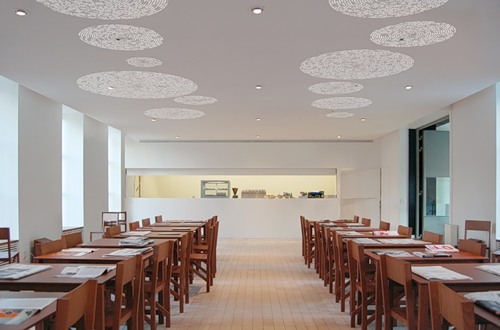ABBYY Recognition Server and Contemporary Art

Everything original is absolutely sudden.
Once the Dutch designer-experimenter Simon Haydens visited the muse of modern art. And then he called ABBYY and said that to create the Cafe Espresso interior he really needed our product - the one that is “designed for streaming input of forms and organizing electronic archives in companies.” About non-standard use of ABBYY Recognition Server read under the cut.
Interior design through the eyes of the tables ...
The project “Wordweaving” is a living story of a cozy corner, where the tables willingly “read” everything that they put on their surface, “remember” a variety of things (from newspaper headlines to the name of cigarettes) and “share” them with new visitors to the cafe. Words and phrases read together with guests are displayed on the ceiling (just above the surface of each table) and are twisted into rings. The more popular the table, the more memories he has - i.e. the more rings in the text lace above it.
The process of mutual communication between the table and the visitor does not end there: the words that your silent companion liked, fly off to the cash register and are printed at the bottom of your account. Now this is not just a check, but a kind of souvenir. And proof that you have become part of the Cafe Espresso story.
... and through the eyes of the Recognition Server
Technically, the Wordweaving project looks like this. Motion sensors built into the surface of the tables are connected to the camera - it takes pictures of the reading matter that guests put in front of them. Recognition Server grabs text from the snapshots, recognizes it and displays the result on the projection display. If the photo turns out to be fuzzy or small, if it is taken at an angle or with “superfoots,” then before converting it to text, the program will “clean” it and turn it over, as well as correct words that look blurry. Huge amounts of data coming from all eight tables to the head center are processed at a record speed of 32 images in 5 seconds.
The capture and processing of text takes place on a Windows server. What happened is sent to another server where Linux is installed - here words and phrases are twisted into a spiral and projected onto the ceiling. Everything works autonomously, without the intervention of programmers and Mr. Hayden. At the same time, for unobtrusive monitoring of the process, a remote console is provided, and to prevent all kinds of errors - automated fault tolerance (AO). The AO algorithm is extremely simple: the system intelligently distributes tasks and verifies their implementation. If a problem occurs, the program throws the stalled task further, bypassing the lock or failure. AO is resistant to the fall of operating systems and, if anything, can itself bring itself to life.
“
Mr. Haydens did a great job of installing and configuring sensors, cameras, servers, and programs himself - it took him a month (including the design of the rest of the room). As a result, the Wordweaving project turned into an original installation that adorned the Dutch Museum of Modern Art in Rotterdam. In the first week alone, the “reading” tables received nearly 3,000 reading visitors - and nothing broke. Now Cafe Espresso boasts an impressive archive of its own memories and panoramic text lace on the ceiling.
And we learned how else to use our product :)
Elena Agafonova,
Translator
